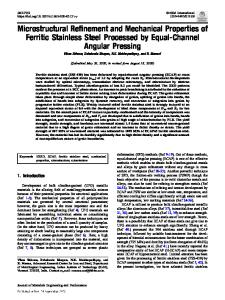Microstructures and mechanical properties of melt-quenched ferritic stainless steels
- PDF / 4,282,957 Bytes
- 9 Pages / 594 x 774 pts Page_size
- 48 Downloads / 468 Views
I.
INTRODUCTION
MELT-quenching of steels leads to various metallographic effects such as refinement of grain size, extension of the solid solubility of carbon and alloying elements, and formation of nonequilibrium phases. These effects are expected to improve the mechanical properties of conventional steels. Furthermore, this technique is a useful method for producing sheets directly from the melt for materials that have less formability in the solid state. And it should lend itself to development as a continuous cast process which offers significant savings in energy and product costs. With these considerations in mind, several studies have investigated melt-quenched Fe-C-X ternary alloys, where X is a ferrite-former, t-~ Various nonequilibrium phases were observed and the effect of ferrite-former elements on the properties of nonequilibrium austenite were clarified. These alloys had good mechanical properties, such as high hardness and strength, due to the large solid solution hardening of these fen-ite-former elements. Fujiwara et al. 6 have investigated the structures and properties of Type 304 and 430 stainless steels quenched directly from the melt and have shown that foils, 0.05 to 0.5 mm thick, of these conventional steels could be produced by the melt-quenching technique. The purpose of this paper is to present the microstructures and the mechanical properties of melt-quenched ferritic stainless steels and to discuss the effect of grain size refinement and addition of alloying elements, especially ferriteformer elements, on these properties.
to stabilize the ferrite and to strengthen the steels by large solid solution hardening as they are ferrite-formers and the difference between their atomic size and that of a-Fe is very large. 7 Mixtures of commercial 17 pct Cr steels (Type 430), and Ti, Nb, Si, or AI were melted under an Ar atmosphere in an induction furnace to prepare the master alloys. The melts were sucked up into quartz tubes (inner diameter: about 4 mm) and solidified there. Melt-quenched ribbon specimens were produced by ejecting a stream of molten alloy between two rotating Cu-Be rolls (diameter: 120 mm). The ribbons were 8 mm wide and 0.04 to 0.16 mm thick. The crystal structure and the microstructure in the asquenched state were examined by X-ray diffraction using filtered Cu-Ka radiation, optical microscopy, and scanning transmission electron microscopy (STEM). The specimens for optical microscopy were prepared by chemical etching in a mixture of 50 pct glycerin, 30 pct hydrochloric acid, and 20 pct nitric acid. The films for STEM were thinned by electropolishing in a mixture of 10 pct perchloric acid and 90 pet ethyl alcohol. The hardness of specimens was measured by a Vickers microhardness tester at 50 g load. The fracture strength, yield strength, and elongation were measured using an Instron-type tensile testing machine at a strain rate of 4.6 x 10-a/s. Figure 1 shows the specimen dimensions for tensile testing. These specimens were cut out from a melt-quenched ribbon using a wire spa
Data Loading...











